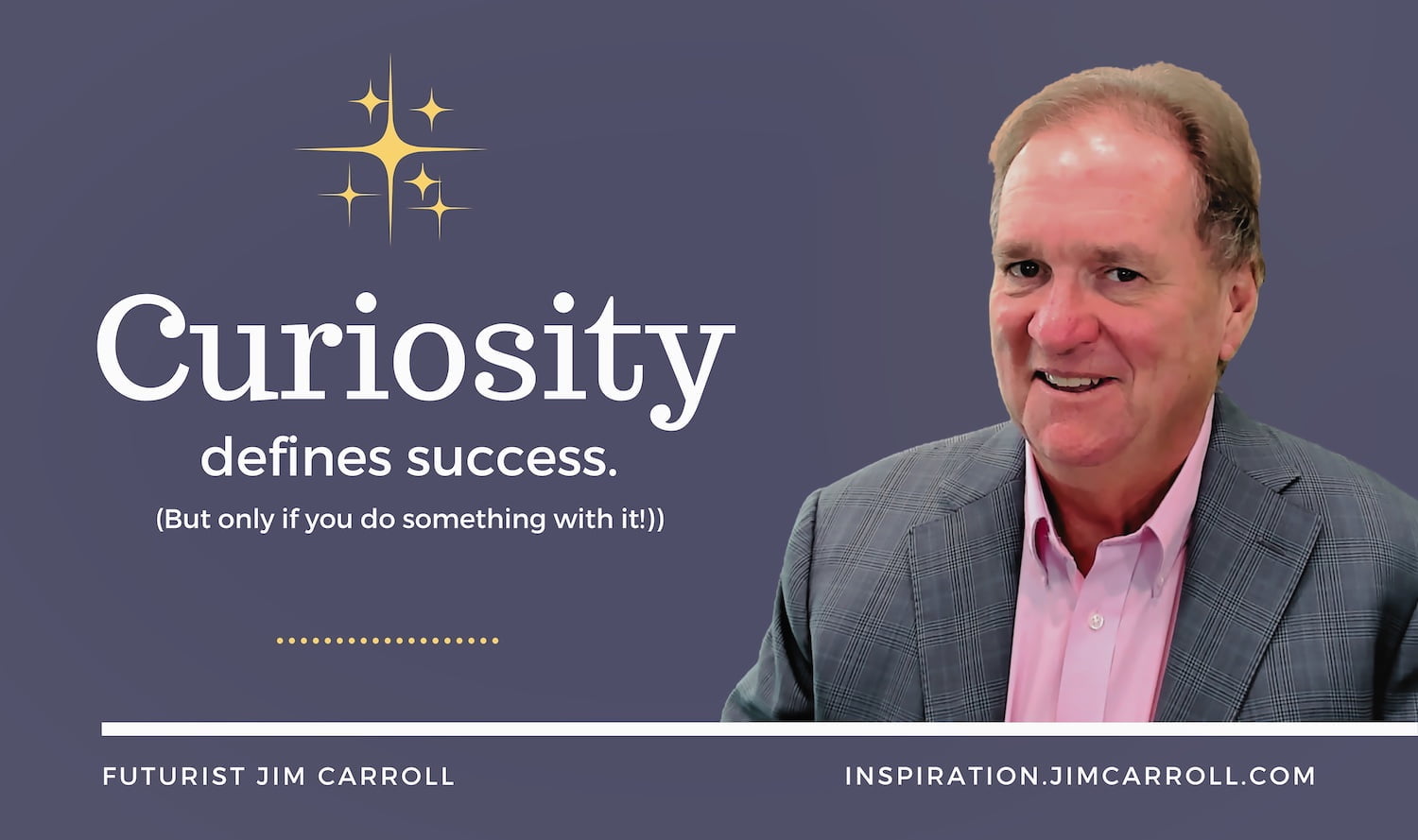“Curiosity defines success. (But only if you do something with it!)” – Futurist Jim Carroll

I waste time. It’s great.
Everyone knows that great things can come from wasted time – so do more of it. Here are some great goals for your day today:
- do frivolous things
- daydream
- explore inconsequential stuff
- gaze into space
- relentlessly explore
- let your mind wander
- invest time in stuff that doesn’t matter
- always wonder ‘how things work’
- pursue useless projects
Why? Because doing these things will feed your curiosity about the world around you – and your curiosity can be the engine for your success. In my case, success comes from understanding trends that shape our world – and if I can participate in the genesis of a trend, I can better understand what’s behind that trend in terms of impact, speed, acceleration, and discovery.
Case in point: I have an odd little hobby that I share with thousands around the world, and my participation has given me deep insight into how global scientists are undertaking the deep research necessary into the fast-moving science of ‘protein folding.’
Huh?
Let’s start here. Just outside my front door, I have this little antennae that is less than 6″ high; it hangs just above the eavestrough.

That antenna is linked to a cheap little computer – around $35 USD – known as a Raspberry Pi that is inside the house.

This little computer runs some software – available for free from various companies – that captures data on all the flights passing over or around my home within a few hundred kilometres. It’s based on a radio signal that all flights must transmit known as “ADS-B – and so, at one moment in time yesterday, it was capturing all these flights in the sky above and beyond the horizon where I live.

…and it busy was feeding all that data on flights – altitude, call sign, airline, type of plane, direction, and speed – to systems such as FlightRadar24, Flightaware, Radarbox, and PlaneFinder. They then package together all this information with dozens of sources to let people see information on real-time flights all over the world. (You can participate in this project – learn more here to start out.
How does this work? Moments ago, early this morning while I wrote this post, my little computer and antenna caught a few flights in the sky, including this Delta flight a hundred or so kilometres to the west of me.

It’s feeding that information in real-time to various online flight systems, so if someone in Boston right about now looks at the status of the flight, they will see something like this:

…with the source of that real-time information coming from my little computer and perhaps a few dozen others in proximity within a few hundred miles of me. All this data is transmitted, synchronized, and summarized by systems like FlightAware. So when you use an app like FlightAware to check on the status of a flight, you now have a rough idea of where this information comes from!
Stepping back a moment I’ve got a few of these systems here and at the chalet. Why do I do this? In my soul, I’m a computer geek, and it was a fun little project to explore. Beyond that though, it gives me some really useful insight into the existing and emerging power to be found in ‘distributed information generation systems’ or ‘collaborative knowledge’ – what happens when thousands or even millions of people contribute information to some new sort of source of knowledge. Think about Wikipedia – the ultimate crowdsourced information platform.
What does this have to do with protein folding, a fast-moving area of medical science research? That science requires a tremendous of computer processing power – and just as I donate my computer processing power to flight systems, others donate theirs to this field of research.
We’ve also seen this idea with distributed science programs for a while – for a time, SETI@Home allowed people to donate spare capacity on their home computers to assist a research program examining radio signals for signs of interstellar life. From that flowed projects like Folding@home, which is a distributed computing project for simulating protein dynamics, and Rosetta@home, which is a distributed computing project for protein structure prediction. Other projects include BOINC (Berkeley Open Infrastructure for Network Computing), an overall ‘platform’ that can be used by various science projects to tap into the unused processing power of volunteers’ computers; it’s currently used for projects involving astronomy, climate modelling, mathematics, and more. Want to be your own Einstein? Explore Einstein@Home, a distributed computing project that searches for gravitational waves in data from various gravitational wave detectors.
There are many such systems. In all of these cases, anyone can participate in a distributed research program with the same type of conceptual framework as what begins with my tiny little antenna on my roof.
And so my totally frivolous activity with my odd little project has helped me understand one of the most powerful trends in the world today – what I like to call distributed information generation systems.
And so by wasting time, I’m actually gaining knowledge.
Waste time!
It’s good for you!





GET IN TOUCH
Jim's Facebook page
You'll find Jim's latest videos on Youtube
Mastodon. What's on Jim's mind? Check his feed!
LinkedIn - reach out to Jim for a professional connection!
Flickr! Get inspired! A massive archive of all of Jim's daily inspirational quotes!
Instagram - the home for Jim's motivational mind!